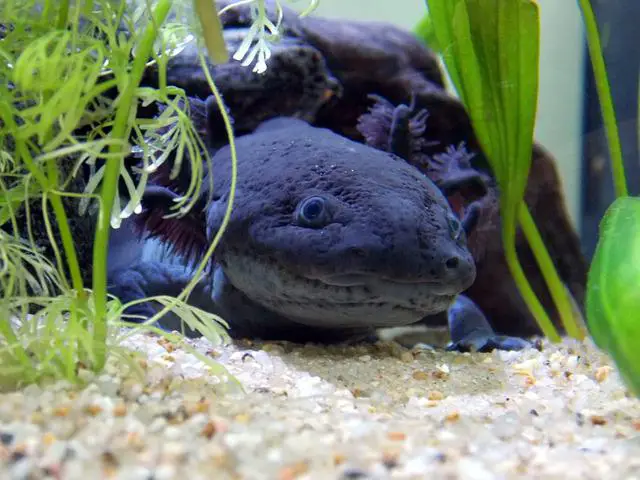Axolotls are unique creatures, so you might assume they have a very complex diet. Axolotls are naturally carnivores, and whether they are feeding in the wild or a pet owner is feeding them in captivity, the diet will revolve primarily around animal-based protein sources.
As a carnivore, their digestive system is developed to break down and utilize meat; however, you might be wondering whether this is the most nutritious diet for an axolotl and whether or not they can eat vegetables.
Axolotls are carnivores and rely primarily on a protein-rich, meat-based diet, so their digestive system is therefore optimized for meat consumption. If you try to feed your Axolotl vegetables, they will not be able to get any nutritional benefit from them, and you should therefore not provide your Axolotl vegetables.
Axolotls are a great beginner pet as they are straightforward to care for and are relatively low maintenance. While you might assume that their diet is complex, you’ll find that they can eat various foods within a specific category for optimal nutrition and health.
In this article, we’ll explain why Axolotls can, but shouldn’t, eat vegetables and why this will offer them little nutritional value and potentially even harm them.

Can Axolotls Eat Vegetables
Firstly, as we pointed out above, an Axolotl is a carnivore, and their primary food source from birth is protein-based meat. This is typically live animals and insects when they are younger; however, adult Axolotl can consume dead meat.
As Axolotls have become increasingly popular pets, the recommended dietary requirements have become more uniform, and below are some of the most typical foods that are recommended for pet Axolotls:
- Earthworms
- Nightcrawlers
- Bloodworms (check out this feeding video for an Axolotl feeding on frozen bloodworms)
- Blackworms
- Daphnia
- Brine Shrimp
- Microworms
- Pellets
- Insects (crickets, mealworms) though this is occasional rather than a staple
As you can see, the diet recommendations are primarily protein-based creatures; pellets might be the exception; however, these need to be made up mainly of a high protein, the animal-based source instead of the primary ingredient being vegetable-based.
Despite being a carnivore, an Axolotl can eat vegetables, and we first need to make that point, so we don’t cause any controversy. The most common instance whereby an Axolotl will eat vegetables in the wild will be when they consume prey that feast on vegetables as a primary food source.
This means that the prey (insect or small animal) will still have undigested vegetable matter in their stomach, including algae, dead grass, leaves, and dirt.
Some pet owners will breed their earthworms in the dirt rich in compost, overripe fruit, and veg to then use this as a way to feed the Axolotl vegetable in a process known as gut-loaded feeding.
This means the live animals you feed your Axolotl already have undigested vegetable matter in their stomachs. As a result, the Axolotl will also digest this when it eats the prey.
This occurs naturally in the wild and is the primary reason an Axolotl can eat vegetables.
Why You Shouldn’t Feed Axolotls Vegetables
Just because an Axolotl can technically eat vegetables, it doesn’t mean that it should, and in general, Axolotls will receive minimal (if any) nutritional value from consuming vegetables.
From birth, an Axolotl will develop its eating patterns (smelling and snapping at food) through live prey as they don’t yet have the instinct to consume dead or frozen food.
On top of developing the ability to eat as they do (food needs to be smaller than their mouth as they swallow food sources whole), an Axolotl doesn’t have the digestive ability to take any nutritional support from vegetables.
Therefore, owning an Axolotl is unlike other pets, whereby you will try to mix up their diet to give them different nutrients and minerals. Trying to feed Axolotls primarily on vegetables could mean they don’t receive the necessary nutrients and could become ill.
Axolotls are also exceptionally sensitive, and vegetables have the potential to carry toxins and parasites that could make the Axolotl ill as well.
While it might seem like vegetables are suitable for your Axolotl, they could provide more harm than nutritional value, so it’s best not to feed them any vegetables.
Round-Up
An Axolotls diet can be surprisingly simple; most of their food source should come from protein-rich meat and possibly some pellets (provided these are also made from protein-rich ingredients).
A diet consisting of a variety of worms, insects, and even small fish can be used, and these are actually what will be most natural to an Axolotl.
You may have been wondering whether they can consume vegetables, and while some Axolotls will eat vegetables, they offer very little nutritional value. A lot of Axolotls will ignore vegetables as a food source.
Therefore, you shouldn’t feed your Axolotls vegetables; following their natural carnivorous diet of protein-rich meat from animals and insects would be best.
- Do Black Caiman Live in Groups? Exploring the Social Behavior of These Large Reptiles
- Do Black Caiman Have Predators? Exploring the Threats to This Amazonian Reptile
- Do Black Caiman Eat Toucans? Exploring the Diet of Black Caimans in the Wild
- Do Black Caiman Eat Sloths? The Truth About the Diet of Black Caiman
- Can a Black Caiman Kill a Human? Exploring the Predator’s Potentially Deadly Bite





